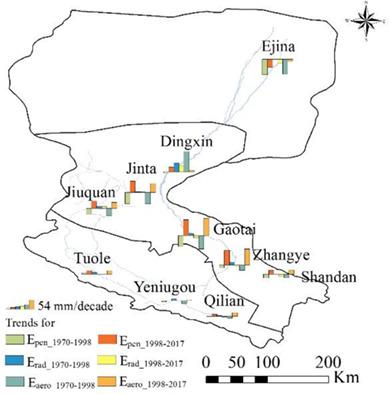当前位置:
X-MOL 学术
›
Hydrol. Process.
›
论文详情
Our official English website, www.x-mol.net, welcomes your feedback! (Note: you will need to create a separate account there.)
Quantitative effects of changes in agricultural irrigation on potential evaporation
Hydrological Processes ( IF 3.2 ) Pub Date : 2021-01-22 , DOI: 10.1002/hyp.14057 Congying Han 1, 2 , Baozhong Zhang 1, 2 , Songjun Han 1, 2
Hydrological Processes ( IF 3.2 ) Pub Date : 2021-01-22 , DOI: 10.1002/hyp.14057 Congying Han 1, 2 , Baozhong Zhang 1, 2 , Songjun Han 1, 2
Affiliation

|
Evaporation is a key element to the basin's water cycle. Agricultural irrigation has resulted in a significant variation of regional potential evaporation (Epen). The spatiotemporal variation of Epen and influencing factors in natural, agricultural, and desert areas in different developmental stages of irrigation in Heihe River Basin (HRB) from 1970 to 2017 were comparatively analysed in this study. This work focused on the correction effect of irrigation on the variation of Epen. Agricultural water consumption in HRB significantly varied around 1998 due to agricultural development and water policy. Under the influence of irrigation, annual variations of Epen in agricultural, natural, and desert areas were significantly different. From 1970 to 1998, the annual trend slope of Epen in natural area only reduced by 1 mm decade−1, while that in agricultural area significantly decreased by 39 mm decade−1. After the implementation of water‐saving irrigation, Epen in natural and agricultural areas increased by 11 and 54 mm decade−1, respectively, from 1998 to 2017. In contrast with natural and agricultural areas, Epen in desert area decreased by 80 mm decade−1 from 1970 to 1998 and continuously decreased by 41 mm decade−1 from 1998 to 2017. However, the regulatory effect of irrigation on Epen in desert area started to manifest due to the expansion of cultivated land area from 2010 to 2017. Irrigation had a significant regulatory effect on the variation of Epen in HRB. The regulatory effect was mainly reflected on the aerodynamic term (Eaero). Results indicated that the main meteorological factors influencing Epen in each region were wind speed, which is 2 m above the surface (U2), and water vapour deficit (VPD).
中文翻译:

农业灌溉变化对潜在蒸发的定量影响
蒸发是流域水循环的关键因素。农业灌溉导致了区域潜在蒸发量的显着变化(E pen)。本研究比较了黑河流域(HRB)1970年至2017年不同灌溉发展阶段天然,农业和荒漠地区E笔的时空变化及其影响因素。这项工作集中在灌溉对E笔变化的校正效果上。由于农业发展和水资源政策的影响,HRB的农业用水量在1998年左右发生了很大变化。在灌溉的影响下,E笔的年变化在农业,自然和沙漠地区差异很大。从1970年到1998年,自然区域E笔的年趋势斜率仅减小了1 mm十年-1,而农业区域中的E笔的年趋势斜率却显着下降了39 mm十年-1。节水灌溉的实施后,ê笔在天然和农业区增加了11和54毫米十年-1分别从1998年至2017年在具有自然和农业区域的对比度,ê笔在沙漠面积减少了80毫米十年-1 1970年至1998年,不断下降41毫米十年-1从1998年至2017年。然而,由于2010年至2017年耕地面积的扩大,灌溉对沙漠中E笔的调节作用开始显现。灌溉对HRB中E笔的变化具有显着的调节作用。调节作用主要反映在空气动力学术语上(E aero)。结果表明,影响E pen的每个区域的主要气象因素是风速(水汽高于地面2 m )(U 2)和水汽亏缺(VPD)。
更新日期:2021-02-23
中文翻译:

农业灌溉变化对潜在蒸发的定量影响
蒸发是流域水循环的关键因素。农业灌溉导致了区域潜在蒸发量的显着变化(E pen)。本研究比较了黑河流域(HRB)1970年至2017年不同灌溉发展阶段天然,农业和荒漠地区E笔的时空变化及其影响因素。这项工作集中在灌溉对E笔变化的校正效果上。由于农业发展和水资源政策的影响,HRB的农业用水量在1998年左右发生了很大变化。在灌溉的影响下,E笔的年变化在农业,自然和沙漠地区差异很大。从1970年到1998年,自然区域E笔的年趋势斜率仅减小了1 mm十年-1,而农业区域中的E笔的年趋势斜率却显着下降了39 mm十年-1。节水灌溉的实施后,ê笔在天然和农业区增加了11和54毫米十年-1分别从1998年至2017年在具有自然和农业区域的对比度,ê笔在沙漠面积减少了80毫米十年-1 1970年至1998年,不断下降41毫米十年-1从1998年至2017年。然而,由于2010年至2017年耕地面积的扩大,灌溉对沙漠中E笔的调节作用开始显现。灌溉对HRB中E笔的变化具有显着的调节作用。调节作用主要反映在空气动力学术语上(E aero)。结果表明,影响E pen的每个区域的主要气象因素是风速(水汽高于地面2 m )(U 2)和水汽亏缺(VPD)。



























 京公网安备 11010802027423号
京公网安备 11010802027423号